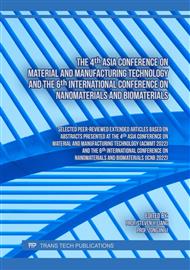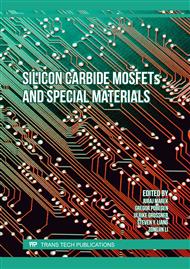[1]
Eshkalak SK, Ghomi ER, Dai Y, Choudhury D, Ramakrishna S. The role of three-dimensional printing in healthcare and medicine. Materials & Design. 2020;194:108940.
DOI: 10.1016/j.matdes.2020.108940
Google Scholar
[2]
Mania S, Ryl J, Jinn J-R, Wang Y-J, Michałowska A, Tylingo R. The Production possibility of the antibacterial filaments by co-extrusion of the PLA pellet with chitosan powder for FDM 3D printing technology. Polymers. 2019;11(11):1893.
DOI: 10.3390/polym11111893
Google Scholar
[3]
Vasickova P, Pavlik I, Verani M, Carducci A. Issues concerning survival of viruses on surfaces. Food and Environmental Virology. 2010;2(1):24-34.
DOI: 10.1007/s12560-010-9025-6
Google Scholar
[4]
Das Jana I, Kumbhakar P, Banerjee S, Gowda CC, Kedia N, Kuila SK, et al. Copper Nanoparticle–Graphene Composite-Based Transparent Surface Coating with Antiviral Activity against Influenza Virus. ACS Applied Nano Materials. 2020;4(1):352-62.
DOI: 10.1021/acsanm.0c02713
Google Scholar
[5]
Huang H, Fan C, Li M, Nie H-L, Wang F-B, Wang H, et al. COVID-19: a call for physical scientists and engineers. ACS nano. 2020;14(4):3747-54.
DOI: 10.1021/acsnano.0c02618
Google Scholar
[6]
Minoshima M, Lu Y, Kimura T, Nakano R, Ishiguro H, Kubota Y, et al. Comparison of the antiviral effect of solid-state copper and silver compounds. Journal of Hazardous Materials. 2016;312:1-7.
DOI: 10.1016/j.jhazmat.2016.03.023
Google Scholar
[7]
Boonkaew B, Kempf M, Kimble R, Supaphol P, Cuttle L. Antibacterial efficacy of a novel silver hydrogel dressing compared to two common silver burn wound dressings: Acticoat™ and PolyMem Silver®. Burns. 2014;40(1):89-96.
DOI: 10.1016/j.burns.2013.05.011
Google Scholar
[8]
Ma J, Zhang J, Xiong Z, Yong Y, Zhao X. Preparation, characterization and antibacterial properties of silver-modified graphene oxide. Journal of Materials Chemistry. 2011;21(10):3350-2.
DOI: 10.1039/c0jm02806a
Google Scholar
[9]
Lee DW, Yoo BR. Advanced silica/polymer composites: Materials and applications. Journal of Industrial and Engineering Chemistry. 2016;38:1-12.
Google Scholar
[10]
Jong L. Synergistic effect of calcium carbonate and biobased particles for rubber reinforcement and comparison to silica reinforced rubber. Journal of Composites Science. 2020;4(3):113.
DOI: 10.3390/jcs4030113
Google Scholar
[11]
Ahmed W, Siraj S, Al-Marzouqi AH. Embracing Additive Manufacturing Technology through Fused Filament Fabrication for Antibacterial with Enhanced Formulated Materials. Polymers. 2021;13(9):1523.
DOI: 10.3390/polym13091523
Google Scholar
[12]
Furka S, Furka D, Dadi NCTCT, Palacka P, Hromníková D, Santana JAD, et al. Novel antibacterial materials designed for the 3D Printing of medical devices used during the COVID-19 crisis. Rapid Prototyping Journal. 2021.
DOI: 10.1108/rpj-09-2020-0219
Google Scholar
[13]
Novak JI, Loy J. A critical review of initial 3D printed products responding to COVID-19 health and supply chain challenges. Emerald Open Research. 2020;2.
DOI: 10.35241/emeraldopenres.13697.1
Google Scholar
[14]
Zuniga JM, Carson AM, Peck JM, Kalina T, Srivastava RM, Peck K. The development of a low-cost three-dimensional printed shoulder, arm, and hand prostheses for children. Prosthetics and orthotics international. 2017;41(2):205-9.
DOI: 10.1177/0309364616640947
Google Scholar
[15]
Abu TM, Zahan KA, Rajaie MA, Leong CR, Ab Rashid S, Hamin NSMN, et al. Nanocellulose as drug delivery system for honey as antibacterial wound dressing. Materials Today: Proceedings. 2020;31:14-7.
DOI: 10.1016/j.matpr.2020.01.076
Google Scholar
[16]
Kahlmeter G, Giske CG, Kirn TJ, Sharp SE. Point-counterpoint: differences between the European Committee on Antibacterial Susceptibility Testing and Clinical and Laboratory Standards Institute recommendations for reporting antibacterial susceptibility results. Journal of clinical microbiology. 2019;57(9):e01129-19.
DOI: 10.1128/jcm.01129-19
Google Scholar
[17]
Moradi M, Kousheh SA, Razavi R, Rasouli Y, Ghorbani M, Divsalar E, et al. Review of microbiological methods for testing protein and carbohydrate-based antibacterial food packaging. Trends in Food Science & Technology. 2021;111:595-609.
DOI: 10.1016/j.tifs.2021.03.007
Google Scholar
[18]
Villapún VM, Dover LG, Cross A, González S. Antibacterial metallic touch surfaces. Materials. 2016;9(9):736.
DOI: 10.3390/ma9090736
Google Scholar
[19]
Perez-Gavilan A, de Castro JV, Arana A, Merino S, Retolaza A, Alves SA, et al. Antibacterial activity testing methods for hydrophobic patterned surfaces. Scientific Reports. 2021;11(1):1-10.
DOI: 10.1038/s41598-021-85995-9
Google Scholar
[20]
Chan SP, Lim DS, Armugam A, Yi G, Zhang Y. Soft Surface Nanostructure with Semi-Free Polyionic Components for Sustainable Antibacterial Plastic. International journal of molecular sciences. 2021;22(22):12315.
DOI: 10.3390/ijms222212315
Google Scholar
[21]
Calovi M, Furlan B, Coroneo V, Massidda O, Rossi S. Facile Route to Effective Antibacterial Aluminum Oxide Layer Realized by Co-Deposition with Silver Nitrate. Coatings. 2022;12(1):28.
DOI: 10.3390/coatings12010028
Google Scholar
[22]
Terry S, Fidan I, Tantawi K. Preliminary investigation into metal-material extrusion. Progress in Additive Manufacturing. 2021;6(1):133-41.
DOI: 10.1007/s40964-020-00151-5
Google Scholar
[23]
Gong H, Snelling D, Kardel K, Carrano A. Comparison of stainless steel 316L parts made by FDM-and SLM-based additive manufacturing processes. Jom. 2019;71(3):880-5.
DOI: 10.1007/s11837-018-3207-3
Google Scholar
[24]
Gante Lokesha Renukaradhya K. Metal Filament 3D Printing of SS316L: Focusing on the printing process. 2019.
Google Scholar
[25]
Lu H. Preliminary Mechanical Characterization of the Low-Cost Metal 3D Printing: Tennessee Technological University; 2020.
Google Scholar
[26]
ltimaker cura software prepares two million print jobs per week. (2020). Manufacturing Engineering, 164(7).
Google Scholar
[27]
Goda ES, Elella MHA, Sohail M, Singu BS, Pandit B, El Shafey A, et al. N-methylene phosphonic acid chitosan/graphene sheets decorated with silver nanoparticles as green antibacterial agents. International Journal of Biological Macromolecules. 2021;182:680-8.
DOI: 10.1016/j.ijbiomac.2021.04.024
Google Scholar
[28]
Wei F, Li J, Dong C, Bi Y, Han X. Plasmonic Ag decorated graphitic carbon nitride sheets with enhanced visible-light response for photocatalytic water disinfection and organic pollutant removal. Chemosphere. 2020;242:125201.
DOI: 10.1016/j.chemosphere.2019.125201
Google Scholar
[29]
Campden, Chorleywood Food Research A. Manual of microbiological methods for the food and drink industry. Chipping Campden [England]: Campden & Chorleywood Food Research Association; 2007.
DOI: 10.1093/ww/9780199540884.013.249900
Google Scholar
[30]
Pandey M, Wasnik K, Gupta S, Singh M, Patra S, Gupta P, et al. Targeted specific inhibition of bacterial and Candida species by mesoporous Ag/Sn–SnO 2 composite nanoparticles: in silico and in vitro investigation. RSC Advances. 2022;12(2):1105-20.
DOI: 10.1039/d1ra07594b
Google Scholar
[31]
Lou G, Chen Y, Xu J, Qian Y, Cheng H, Wei Z, et al. Preparation of Graphene Oxide-loaded Nickel with Excellent Antibacterial Property by Magnetic Field-Assisted Scanning Jet Electrodeposition. International Journal of Bioprinting. 2022;8(1).
DOI: 10.18063/ijb.v8i1.432
Google Scholar



